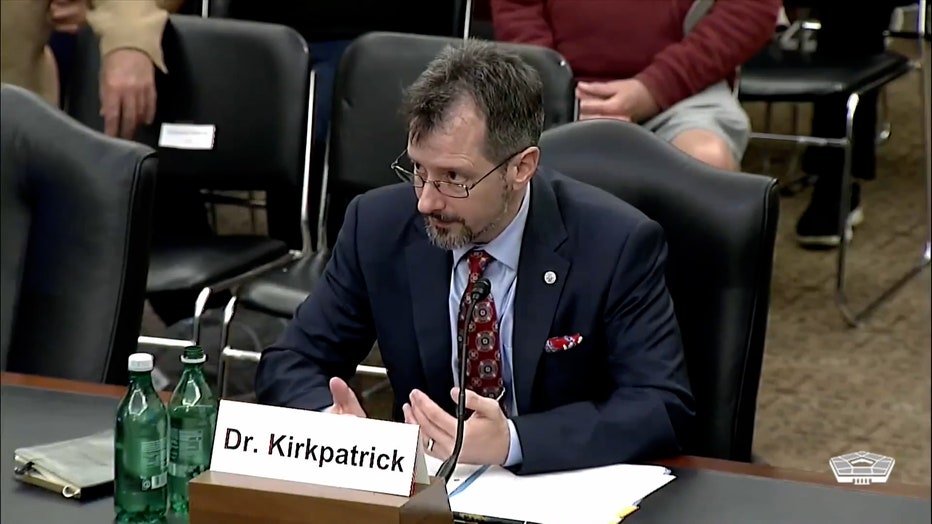Here's what the Pentagon's former UFO hunter learned on the job
The Pentagon official who led efforts to centralize UFO investigations has harsh words for some members of Congress: their "conspiracy driven decision-making" and "sensationalist-dominated governance" is one reason why he left his job.
Dr. Sean Kirkpatrick, a physicist and career intelligence officer, was picked in 2022 to lead the Pentagon’s All-domain Anomaly Resolution Office, or AARO. The agency was created to centralize investigations into unidentified aerial phenomena (UAP), the official government term for UFOs.
In a letter published on Scientific American’s website, Kirkpatrick said his team never found evidence of aliens, but he did encounter "the erosion of critical thinking."

Sean Kirkpatrick (screen shot from NASA video)
"Carl Sagan popularized the maxim that ‘extraordinary claims require extraordinary evidence,’" Kirkpatrick wrote. "This advice should not be optional for policy makers … Our capacity for rational, evidence-based critical thinking is eroding, with deleterious consequences for our ability to effectively deal with multiplying challenges of ever increasing complexity."
RELATED: Ufologist presents alleged 'non-human' bodies to Mexico's Congress
Kirkpatrick said he and the Pentagon "painstakingly" put together a team to create a science-based strategy of investigating UAPs, but conspiracy theorists consistently disrupted their work. Kirkpatrick says the unfounded conspiracy "goes something like this":
"The U.S. has been hiding and attempting to reverse engineer as many as 12 UAP/UFOs from as early as the 1960s and perhaps earlier. This great cover-up and conspiracy failed to produce any salient results, and consequently the effort was abandoned to some private sector defense contractors to continue the work. Sometime later, the story continues, those private sector contractors wanted to bring the whole program back under U.S. government (USG) auspices. Apparently, the CIA stopped this supposed transfer back to the USG."
In July, retired Air Force Maj. David Grusch testified publicly before a congressional committee, claiming the U.S. has concealed what he called a "multi-decade" program to collect and reverse-engineer UAPs.
UFO hearing: Whistleblower says 'non-human biologics' found at crash sites
The House Oversight Committee held a historic hearing on UFOs, which included the testimony of three whistleblowers: David Grusch, Ryan Graves and David Fravor. LiveNOW's Andrew Craft spoke about the bombshell discoveries during today's hearing with Rep. Tim Burchett (R-TN), aerospace analyst Bryan Bender and UFO expert Nick Pope. More LiveNOW from FOX streaming video
Part of what the U.S. has recovered, Grusch testified, were non-human "biologics," which he said he had not seen but had learned about from "people with direct knowledge of the program."
The Pentagon denied his claims, and Kirkpatrick at the time called them insulting. Still, his testimony energized believers in extraterrestrial life and produced headlines around the world.
"Some members of Congress prefer to opine about aliens to the press rather than get an evidence-based briefing on the matter," Kirkpatrick wrote in Scientific American. "Members have a responsibility to exhibit critical thinking skills instead of seeking the spotlight."

A UFO variety was photographed when it hovered for fifteen minutes near Holloman Air Development Center in New Mexico. The object was photographed by a government employee and was released by the Aerial Phenomena Research Organization after careful s
Kirkpatrick said despite their public cries about aliens and government cover-up, the members of Congress who elevated conspiracy theories never met with Kirkpatrick’s agency, "despite numerous invitations."
"Science cannot be left on the side of the road in the mad dash to uncover some great conspiracy," Kirkpatrick wrote. "Carl Sagan would expect no less, and neither should the American people."
The Associated Press contributed to this report.

